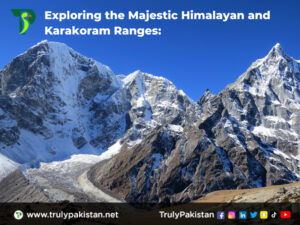Geological Origins: A Remarkable Convergence
The Himalayas: Nature’s Monument to Plate Tectonics
The Himalayas, sometimes known as the “abode of snow,” form an extensive mountain range that traverses five countries: India, Nepal, Bhutan, China, and Pakistan. Stretching over a distance exceeding 1,500 miles, the Himalayas owe their origin to a fascinating and continuing geological convergence. Approximately 50 million years in the past, the Eurasian plate encountered the gradually progressing Indian tectonic plate. The Himalayas are currently being lifted as a result of this collision. The effects of this enormous geological occurrence are astounding and provide a gripping narrative for geologists and adventurers alike.
Karakoram Range: The Crown Jewel of Mountains
In the northern expanse of Pakistan lies the Karakoram Range, a geological phenomenon showcasing some of the Earth’s most towering summits. As part of the larger Himalayan Range, it encompasses challenging mountains like K2, the second-highest peak on Earth. The spectacular scenery of the Karakoram is a tribute to nature’s unrelenting forces, having been fashioned by the same tectonic collision that gave rise to the Himalayas. In addition to being a natural marvel, the Karakoram Range is a haven for climbers and hikers and tests their stamina.
The Magnificent Landscapes: A Photographer’s Dream
Himalayan Beauty: Peaks and Valleys
The variety of scenery available in the Himalayas is unmatched. Every view in this range is a work of beauty, from the snow-capped peaks piercing the skies to the lush green lowlands ornamented with meandering rivers. With a height of 29,032 feet, the formidable Mount Everest serves as a global compass for mountaineers. Numerous natural treasures can be discovered by trekking via the Annapurna Circuit in Nepal or by visiting the beautiful valleys of Himachal Pradesh, India. The trail’s bends show stunning views and unusual flora and animals.
Karakoram’s Rugged Charm
In sharp juxtaposition to its adjacent Himalayan counterpart, the Karakoram Range presents a rugged and formidable terrain. This relentless landscape, characterized by rugged summits, perilous glaciers, and desolate deserts, has garnered a reputation as one of the most demanding mountain ranges globally for climbers to conquer. With towering peaks all around it, the captivating Baltoro Glacier is a sight to behold. You will be mesmerized by the harsh beauty of the Karakoram’s sheer cliffs, glaciers, and high-altitude deserts as you travel across it.


Cultural Diversity: The Human Tapestry
Himalayan Culture: A Melting Pot of Traditions
The Himalayan region serves as a captivating cultural nexus, inhabited by an array of nations, languages, and faiths. In the Eastern Himalayas, one can discover a captivating blend of cultures, from the esteemed Sherpas of Nepal, known for their unwavering resolve and mastery of mountainous terrain, to the distinctive realm of Bhutan, where grand-scale aspirations shape a unique world of ambition and tradition.
The Himalayas have witnessed the Sherpas emerge as esteemed figures in the realm of mountaineering, their reputation soaring as some of the region’s foremost climbers. Their steadfast resolve and proficiency in high-altitude climbing are indispensable for adventurers from around the globe. In the secluded realm of Bhutan, nestled within the Eastern Himalayas, a distinct world unfolds, driven by grand state interests.
The Himalayan region offers a vibrant cultural tableau, with tranquil Buddhist monasteries in Ladakh and bustling markets in Kathmandu. Travelers can engage in a rich array of traditions, spanning ancient religious rituals to customary festivals and celebrations, creating a truly immersive experience.
The Himalayan region truly stands as a remarkable locale, where natural beauty coalesces with cultural diversity in abundance. It is a destination where travelers can gain insight into diverse ways of life and embark on a one-of-a-kind and unforgettable cultural journey.

